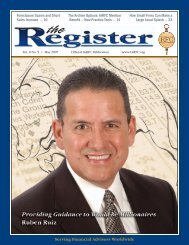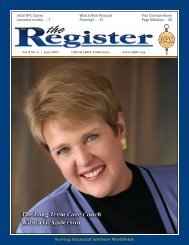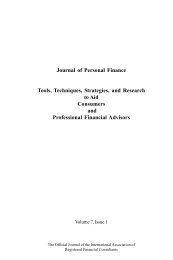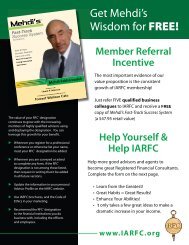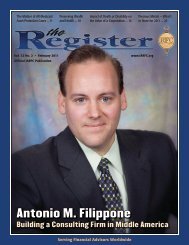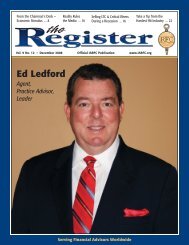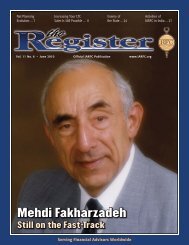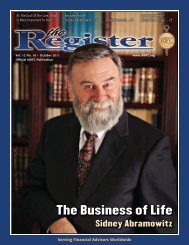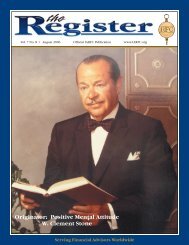3433-vol. 6 issue 2-3.pmd - iarfc
3433-vol. 6 issue 2-3.pmd - iarfc
3433-vol. 6 issue 2-3.pmd - iarfc
Create successful ePaper yourself
Turn your PDF publications into a flip-book with our unique Google optimized e-Paper software.
Volume 6, Issue 2 & 3 73<br />
The user can quickly page back up to the start date and run the<br />
retirement strategy over other time periods and easily see the results in<br />
Worksheet 2 and the charts. Example’s strategy does better over some other<br />
periods such as 1928-68 and 1950-90. In these periods, the stock dominated<br />
portfolio grows to over $1 million in early retirement and can support LTC<br />
costs or a much higher target income. In the 1965-2005 period, the stock<br />
portfolio runs out of funds at the end. Then the user can build another longterm<br />
financial retirement strategy (e.g, starts retirement later or saves more)<br />
and run that strategy over similar time periods.<br />
Discussion and Conclusions<br />
The major benefits of the HRPM model based on actual yearly<br />
historical returns stems from its ability to run different long-term financial<br />
retirement strategies over different historical periods and allow the user to<br />
experience the year-by-year “bumps” in the road. This provides a basis for<br />
forming impressions (subjective probability distributions) about ranges of<br />
possible outcomes for different strategies. Traditional projector models based<br />
on long-run average or geometric mean returns may give quicker, easier-to-use<br />
estimates of savings needed for different portfolio strategies. However,<br />
individuals save for and retire during specific periods that experience widely<br />
different returns and resulting portfolio values. Simulation type models may<br />
pick up some of this risk by using low and high returns for various portfolios<br />
over different time periods. Nevertheless, even those simulations do not<br />
show the year-by-year changes in assets (van Welie, Janssen & Hoogstrate,<br />
2004). Thus, they may miss the timing of major events which can change<br />
long-run portfolio values, resulting retirement income, and even retirement<br />
strategies such as target income, time of retiring, and portfolio mixes.<br />
The enhancements in the present version of the Historical Retirement<br />
Income Projector Model (HRIPM) should help make the model accessible and<br />
usable for a wider audience. The shift to Excel makes the program readily<br />
accessible to virtually all users with basic computer spreadsheet skills<br />
(updated model available free of charge from authors, see Footnote 1). Also,<br />
the new charts of retirement assets and income make the output easier to<br />
visualize and provide more information on short-term risks of asset <strong>vol</strong>atility.<br />
The addition of long-term care, medical, and other costs expands the retirement<br />
income projections over a wider range of risks. Thus, financial educators,<br />
professional advisors, and individuals should find the model useful for<br />
illustrating some of the investing principles and pitfalls of various long-run<br />
portfolio strategies such as stocks for the long-run (Siegel, 2002) based on<br />
modern portfolio theory (Markowitz, 1954; Sharpe, 1964) versus more conservative<br />
portfolios (e.g., Shiller, 2005).<br />
Research & Theory



